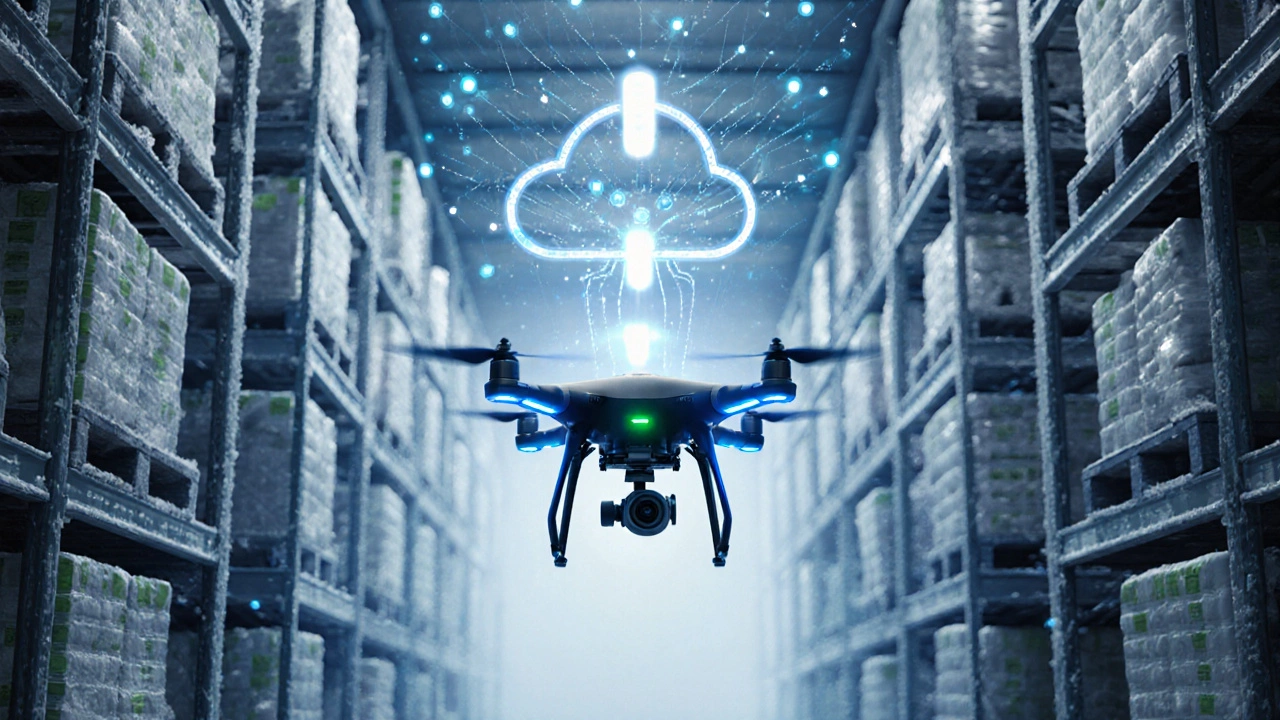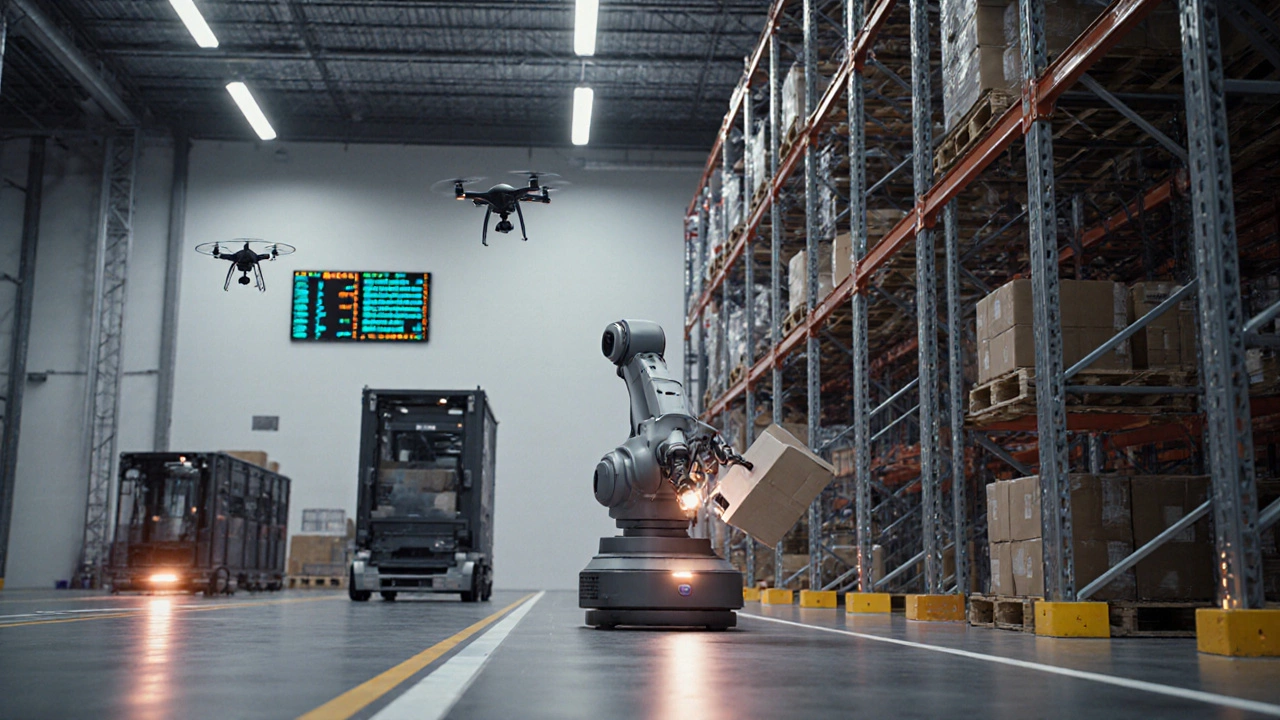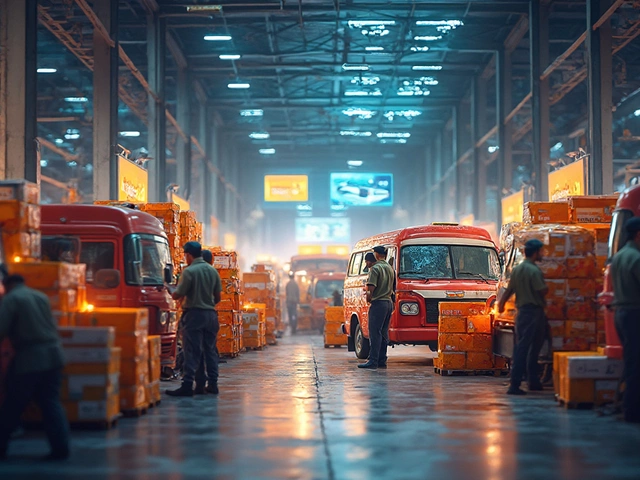Warehouse Technology ROI Calculator
Calculate Your Potential ROI
Determine how much time, labor, and money you could save by implementing modern warehouse technologies.
When you step into a 50,000‑square‑foot distribution center today, you’ll hear robots humming, see drones zip along aisles, and notice screens flashing real‑time data. That’s the result of modern warehouse technologies advanced tools and systems that automate, monitor, and optimize storage and fulfillment operations reshaping how goods move.
Key Takeaways
- Robotics and AGVs handle up to 60% of repetitive motion tasks.
- IoT sensors cut inventory errors by 30% and improve space utilization.
- Cloud‑based WMS platforms enable real‑time decision making across multiple sites.
- Drones and AR speed up cycle counting by 2‑3×.
- Successful adoption hinges on data integration, staff training, and phased rollout.
Why modern warehouse technologies matter now
Retailers are racing to meet sub‑day delivery expectations, while e‑commerce volumes keep rising. Traditional pick‑and‑pack lanes simply can’t keep up, and labor shortages add pressure. By layering automation, connectivity, and analytics, companies gain three core benefits: speed, accuracy, and scalability. In 2025, a typical mid‑size warehouse sees a 20‑25% increase in throughput after deploying just two of the technologies outlined below.
Robotics: The heavy‑lifting workhorse
Robotics Machines that perform tasks such as picking, packing, and palletizing with minimal human input have moved from isolated cells to collaborative fleets. Collaborative robots (cobots) work side‑by‑side with operators, using vision systems to identify items and gently handle fragile goods. Major vendors like Boston Dynamics and Locus Robotics report ROI within 12-18 months for high‑volume SKU environments.
Automated Guided Vehicles (AGVs)
Automated Guided Vehicles Self‑driving carts that transport pallets, bins, or shelves along predefined routes free up floor space and reduce travel time. Modern AGVs use laser navigation and can dynamically reroute around obstacles, cutting travel distance by up to 35% compared with manual forklifts.
Warehouse Management System (WMS) in the Cloud
Warehouse Management System Software that orchestrates inventory, labor, and equipment across the warehouse floor has shifted from on‑premise boxes to SaaS platforms. Cloud WMS offers multi‑site visibility, API connectivity to ERP and e‑commerce platforms, and AI‑driven slotting recommendations. Companies adopting a cloud WMS see order‑lead‑time reductions of 15% on average.

Internet of Things (IoT) Sensors
Internet of Things Networked sensors that capture temperature, humidity, motion, and weight data in real time provides the eyes and ears of a smart warehouse. RFID tags combined with Bluetooth Low Energy beacons enable real‑time location tracking of each pallet, while environmental sensors ensure compliance for temperature‑sensitive products.
Cloud Analytics & AI
Data generated by robots, AGVs, and IoT devices feeds into cloud analytics platforms. Machine‑learning models forecast demand spikes, suggest optimal labor schedules, and predict equipment maintenance windows. The result is a proactive, rather than reactive, operation.
Drones for Inventory Checks
Drones Small quad‑copter devices that scan barcodes or RFID tags from the air can scan entire aisles in minutes. A 30‑minute drone flight can verify inventory accuracy for up to 10,000 SKUs, a task that would take a team of movers several hours.
Augmented Reality (AR) Picking
Augmented Reality Wearable glasses or handheld devices that overlay picking instructions onto the physical world guide workers directly to the right shelf, highlight the exact bin, and confirm the correct quantity. Trials report a 25% increase in pick speed and a 40% drop in mis‑picks.

Technology Comparison Table
| Technology | Core Function | Typical ROI Period | Key Vendor(s) |
|---|---|---|---|
| Robotics | Picking, packing, palletizing | 12-18 months | Boston Dynamics, Locus Robotics |
| Automated Guided Vehicles | Material transport | 9-15 months | Swisslog, Dematic |
| Cloud WMS | Inventory & labor orchestration | 6-12 months | Manhattan Associates, SAP Extended Warehouse Management |
| IoT Sensors | Real‑time environment & location monitoring | 8-14 months | Siemens, Zebra Technologies |
| Drones | Rapid cycle counting | 10-16 months | SKU‑Radar, FlytBase |
| AR Picking | Guided picking assistance | 7-13 months | Vuzix, Scope AR |
Implementation Checklist
- Map current workflows and identify bottlenecks.
- Choose a pilot zone (e.g., fast‑moving SKUs) and select one technology to test.
- Ensure data standards: barcode quality, RFID tag formats, API compatibility.
- Train staff on new interfaces and safety protocols.
- Monitor KPIs - pick rate, error rate, equipment utilization - for at least 90 days.
- Scale gradually, adding complementary technologies that address adjacent pain points.
Common Pitfalls & Pro Tips
Pitfall: Deploying several systems at once without a data integration layer. Tip: Start with a middleware platform that normalizes IoT, WMS, and robot feeds.
Pitfall: Ignoring change‑management; workers resist new tools. Tip: Involve floor staff early, run hands‑on workshops, and celebrate quick wins.
Pitfall: Over‑engineering a small warehouse. Tip: Match technology scale to order volume - a midsize e‑commerce hub may only need AGVs and a cloud WMS, while a large fulfillment center can add drones and AR.
Frequently Asked Questions
Which technology gives the fastest ROI?
For most mid‑size distributors, a cloud‑based WMS or a fleet of AGVs delivers ROI within 9‑12 months because they immediately reduce labor hours and travel distance.
Do I need a robotics specialist to install cobots?
Many vendors provide turnkey kits and remote commissioning. A basic safety training for staff plus a quick site survey is often enough.
How does IoT improve inventory accuracy?
IoT tags continuously broadcast location and status, so the system can flag misplaced pallets instantly, cutting manual recounts by up to 30%.
Can drones be used in cold‑storage warehouses?
Yes, provided the drones are rated for low‑temperature operation and the battery chemistry is chosen for the ambient conditions.
What security concerns arise with cloud WMS?
Data encryption in transit and at rest, role‑based access controls, and regular penetration testing are essential to protect inventory data.
Next Steps
Start by auditing your current layout and order flow. Pick the technology that tackles the biggest bottleneck - whether that’s manual picking, long travel distances, or inaccurate counts. Then follow the checklist above, measure results, and iterate. Modern warehouse technologies aren’t a one‑size‑fits‑all solution; they’re a toolkit you can expand as your business grows.





